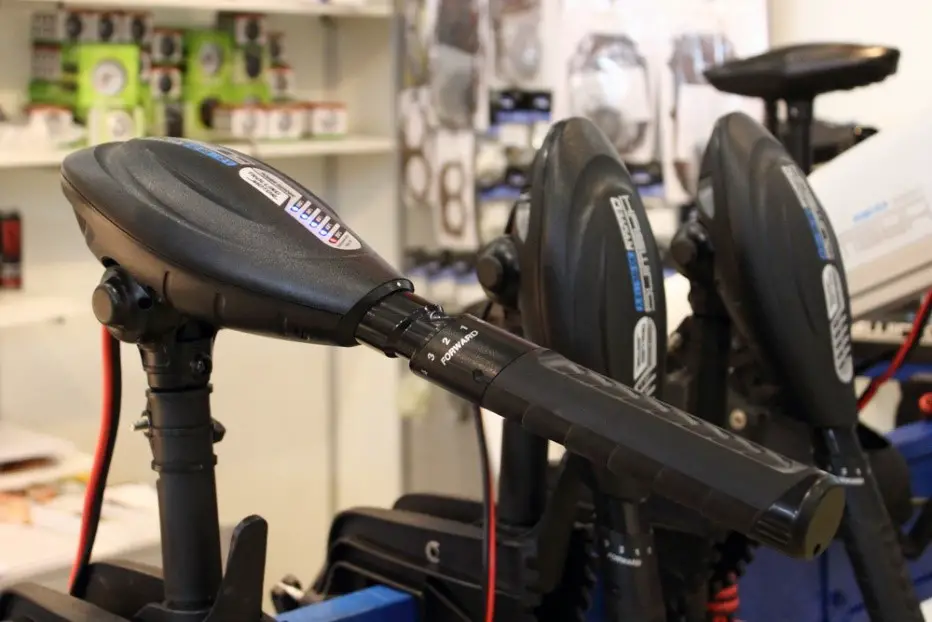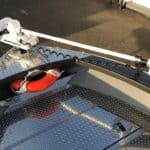Pontoon boats give us the best of both worlds. You can pack your boat with friends and family who enjoy leisurely floating the water while you fish off the other side of the boat. When you want to take a break from fishing, you can put your rods in a rod holder rigged with bait and troll the water while you socialize with your crew.
Electric trolling motors are a great accessory to have on your pontoon boat because it saves your gas motor from running, especially when you’re not trying to quickly get from one place to the next. You can casually float the water using a trolling motor, and we’ll tell you exactly how to do that.
When you use electric trolling motors for your pontoon boat, you’ll need to know your boat length and weight to know what size trolling motor to use and if you’ll need to use more than one.
You’ll also need to consider if you’ll be fishing in freshwater or saltwater. If you’re fishing in saltwater, you’ll want to choose a saltwater electric trolling motor. A saltwater trolling motor will have protection in place to prevent the motor components from becoming corroded from the abrasive saltwater.
We’ve got the answers to all the questions you may have about how to use electric trolling motors for pontoon boats in this how-to guide.
Electric Trolling Motor Size Guide
In addition to knowing the length and weight of your pontoon boat, you’ll need to know the shaft length of the trolling motor. You can read our guide for more detailed information about the shaft length of trolling motors and why that is important.
Minn Kota is one of the leading trolling motor companies in the world. They have created a helpful chart for you to determine what size trolling motor you need. This chart can be found on the Minn Kota website:
| Boat Weight (lbs) | Max Boat Length (ft) | Recommended Minimum Thrust Level (lb of thrust) | Batteries Needed |
| 1,500 or less | 14’ | 30 | 1 battery (12v) |
| 2,000 | 17’ – 18’ | 40 – 50 | 1 battery (12v) |
| 2,500 | 20’ – 21’ | 50 – 55 | 1 battery (12v) |
| 3,000 – 3,500 | 23’ | 70 | 2 batteries (24v) |
| 4,000 | 25’ | 80 | 2 batteries (24v) |
| 4,500 or more | 25’+ | 101 – 112 | 3 batteries (36v) |
Where to Mount a Electric Trolling Motor on a Pontoon Boat
Don’t just slap the trolling motor onto your pontoon boat and think you’re ready to go. There are designated places where you will want to mount your trolling motor. You can mount it on the bow, transom, or engine.
The location you place the trolling motor will have different effects on how the pontoon boat will troll, so it’s important to understand the differences between the locations to decide where you should place your electric trolling motor.
Bow Trolling Motor
Many boaters place electric trolling motors on the bow because of how much steering control you get when the trolling motor is placed on the bow. When the trolling motor is placed on the bow of the boat, it pulls the boat in the direction you want to go rather than pushes it.
Pros
- Control
- Power
- Effectiveness
Cons
- Expensive
- Takes up room
Transom Trolling Motor
If you’re worried about space, then you may want to mount your electric trolling motor on the transom. The transom is the small, flat section at the rear of the boat that supports the engine. Mounting the trolling motor onto the transom will save you space on your pontoon boat deck if space is an issue.
Pros
- Takes up virtually no space
- Affordable
- Easy to install
Cons
- Not as much power and control
Engine Trolling Motor
You can mount an engine trolling motor directly onto your pontoon boat’s engine. They are extremely convenient because they are placed in the same location already being taken up by your pontoon boat’s engine.
Pros
- Takes up virtually no space
- Convenient
- Easy to install
Cons
- Expensive
- Not as much control
Batteries, Foot Pedals, and Other Accessories for Electric Trolling Motors
You can add many accessories to your electric trolling motor that will make trolling your pontoon easier.
Batteries
Trolling motor batteries will last about 5 hours before recharging or replacing with another charged motor battery. Keep in mind that depending on the length and weight of your boat will determine how many batteries you will need to power your electric trolling motor.
If you plan to be trolling the water for most of the day, you should plan to have two sets of fully charged batteries. Otherwise, you can use your gas engine to get to your location and then use your trolling motor to troll. You can then return to the boat ramp or marina by using your gas engine, saving your trolling motor for trolling.
Click here to read our article Lithium Trolling Motor Batteries
Foot Pedals
Many trolling motors already come equipped with a foot pedal. A foot pedal allows you to control the speed of the trolling motor with your foot, leaving your hands free to fish, steer, or drink a beverage while trolling. Foot pedals are very common on bass boats or jon boats because they work well with the low-profile front deck.
We recommend choosing an electric trolling motor that comes with a foot pedal so that you don’t have to convert a hand-controlled trolling motor to a foot-controlled trolling motor. However, if you want to add a foot pedal to your hand-controlled trolling motor, it’s easy to do.
If you have experience in electrical work, you can easily convert your hand-controlled trolling motor into a foot-controlled trolling motor. You’ll need to cut the wires within the motor and connect them by soldering them or crimping them together. Then, secure the connection in place with electrical tape.
Don’t worry if you don’t have electrical experience. You can hire a professional electrician to convert your hand-controlled trolling motor to a foot-controlled trolling motor. We recommend using an electrician who has experience in working on boat electricity.
Minn Kota now makes a wireless foot pedal trolling motor that you can place anywhere on your boat. If you need to move to the other side of the boat, just take the wireless foot pedal with you and control the motor from your location.
Bluetooth Connectivity
Some trolling motors come equipped with Bluetooth connectivity. You can control your trolling motor through an application on your smartphone. You can also set your trolling motor on autopilot through the Bluetooth connection. You can adjust the route and speed of the trolling motor through your smartphone without having to get up or move to another location.
Fishfinder Compatibility
If you plan to do a lot of fishing while trolling on your pontoon boat, then you may want to choose an electric outboard motor that has fishfinder capabilities. When you use a trolling motor that connects to your fishfinder or includes its own fishfinder, you use two products simultaneously.
Instead of studying your fishfinder while also trying to control the trolling speed and direction of your trolling motor, you can perform both tasks simultaneously within the same application. This makes it easy and convenient to fish while trolling on your pontoon.
Click here to read our article Best Trolling Motor and Fishfinder Combo
Why You Should Use a Electric Trolling Motor When Fishing
Fishing with a trolling motor on your pontoon boat has many benefits. If you’re just considering using electric boat motors for your pontoon boat, we’ll give you a few reasons as to why this is a good idea.
Electric Trolling Motors Are Quiet
Fish can spook easily, especially from the loud noises that come from gas engines. Using a trolling motor allows you to quietly troll through areas where fish are schooling or even bedding down.
Electric Trolling Motors Maintain a Steady Speed
Even running your gas motor at the lowest 5 mph thrust can be too fast when you want to troll for fish. When fishing, you’ll only want to troll between .5 mph and 1.5 mph.
Of course, if you’re leisurely trolling, you may want to go faster than that, but you’ll be using the gas from your gas-powered engine to do that, as the gas engine will turn about 1,300 rpm to do that. With an electric trolling motor, you can easily maintain a steady speed without having to babysit the engine or use gas.
Electric Trolling Motors Save Gas
Gas-powered engines are great for playing on the water, especially when you have a pontoon that will allow you to do virtually any activity you want on the water.
Want to pull a tube? Get a pontoon.
Want to fish? Get a pontoon.
Want to relax and float? Get a pontoon.
Want to invite your 20 best friends for a lake party? Get a pontoon.
But you’ll likely not spend your entire day on the water running your gas-powered engine at full speed, so you need an option that allows you to leisurely float without using up all your gas.
That’s where the trolling motor comes in.
Whether you’re fishing, floating, or just taking a break, an electric trolling motor is exactly what you need. With a trolling motor, you can save the gas in your gas-powered engine for the time when you need to quickly move from point A to point B or when you’re ready to head back to the boat dock or marina for the day.
Final Thoughts
If you haven’t added an electric pontoon trolling motor to your pontoon, you should. You don’t have to be an active fisherman to need a trolling motor on your pontoon. You can use an electric trolling motor when you simply just want to casually float the water on your pontoon.
You’ll need to measure the length and weight of your pontoon to know how much thrust you’ll need the trolling motor to have so that it can successfully push or pull your boat, depending on where you mount the trolling motor on your fishing boat of course.
Your pontoon trolling motor can be as basic or as elaborate as you want, with various bells and whistles like Bluetooth connectivity and a fishfinder. Just make sure your batteries are charged, or you’ll be using your gas motor for the day!
FAQ
How Much Thrust Do I Need for My Pontoon Boat?
There’s an easy rule of thumb that you can remember when determining how much thrust you need for your pontoon boat.
It’s 2 pounds of thrust for every 100 pounds of boat weight; this includes gear, equipment, and passengers.
For example, if you have a pontoon boat with a total weight of 3,000 pounds, you will do a simple calculation.
Take 3,000 and divide by 100 to get 30. Then, multiply 30 by 2 to get 60 which is the minimum recommended weight of thrust using this simple rule of thumb.
Can I Use a Electric Trolling Motor Only?
You can use just an electric trolling motor as your only engine for your pontoon boat; you’ll just need to make sure you have enough thrust and enough battery power so that you don’t become stranded on the water. However, it’s not something we would recommend.
Trolling motors are a great addition to have on your pontoon boat because they give you the option to troll without using a loud gas motor to do so.
If you want your trolling motor to be the only engine on your boat, you’ll need more than one trolling motor to move the pontoon. It’s doable, but we wouldn’t recommend it.
What Does it Mean to Have a Electric Trolling Motor with Variable Speeds?
We recommend variable speed trolling motors because this kind of electric motor gives you the option of trolling at various speeds in your small pontoon boat.
Most variable speed trolling motors have five different speeds to choose from, with the first speed being the slowest and the fifth speed being the fastest.
Variable speed trolling motors usually have reverse speeds as well that will allow you to troll the boat in reverse.
Try to go with what’s known as an 8-speed trolling motor. These trolling motors have five forward speeds and three reverse speeds, giving you eight total speeds to choose from.



